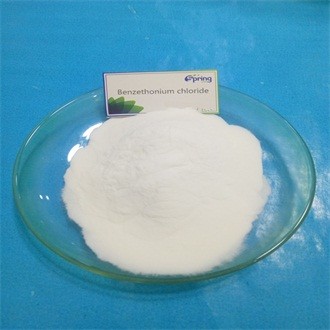To enhance the surface activity of Benzethonium chloride as a bactericidal disinfectant, several strategies can be employed. Surface activity refers to the ability of a substance to interact with the surface of a material or organism, facilitating its disinfecting properties. Here are some approaches to improve the surface activity of Benzethonium chloride:
Surfactant incorporation: Surfactants are compounds that lower the surface tension between liquids or between a liquid and a solid. By incorporating suitable surfactants into Benzethonium chloride formulations, the surface activity can be enhanced. Surfactants can increase the spreading ability and contact time of the disinfectant on the surface, improving its effectiveness.
pH adjustment: pH plays a crucial role in the activity of disinfectants. Adjusting the pH of Benzethonium chloride solutions to an optimum level can optimize its surface activity. Generally, a slightly acidic or neutral pH range is preferred for better disinfection efficacy. pH adjustment can be achieved by adding acids or bases to the solution.
Formulation optimization: The formulation of the disinfectant can be modified to enhance surface activity. This includes adjusting the concentration of Benzethonium chloride, selecting suitable solvents, and incorporating additional ingredients such as co-solvents or wetting agents. Careful formulation design can improve the wetting ability and overall surface coverage of the disinfectant.
Synergistic combinations: Combining Benzethonium chloride with other disinfectants or antimicrobial agents can have a synergistic effect on surface activity. Certain compounds, such as alcohols or quaternary ammonium compounds, can complement the activity of Benzethonium chloride and enhance its ability to penetrate and disrupt bacterial membranes.
Application technique: The manner in which the disinfectant is applied can also impact its surface activity. Ensuring proper contact time, using suitable application methods (e.g., spraying, wiping), and employing techniques that promote thorough coverage of the target surface can maximize the disinfectant's effectiveness.
Testing and optimization: It is crucial to test and evaluate the modified formulations for their surface activity and disinfection efficacy. Conducting laboratory studies and real-world evaluations can provide insights into the performance of the enhanced Benzethonium chloride formulation, allowing for further optimization if needed.
By implementing these strategies, the surface activity of Benzethonium chloride as a bactericidal disinfectant can be improved, leading to more effective disinfection outcomes. It is important to note that safety considerations, regulatory requirements, and compatibility with target surfaces should be taken into account during the modification process.
Post time: May-31-2023


